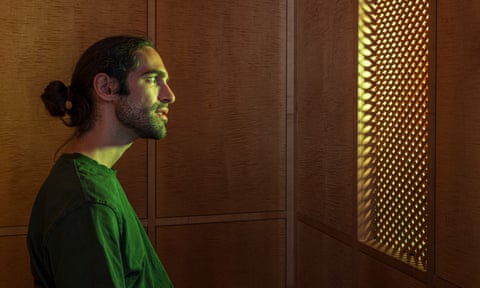DEUS in MACHINA: Swiss Catholic Church Installs an AI Jesus
 |
| People visiting the booth were advised not to disclose any personal information. Photograph: Peter Diem/Lukasgesellschaft |
When I was a kid I was told if I wanted to talk to Jesus to put my knees on the ground. When I was in a Protestant Bible Institute or Seminary was told the same thing but also just to think of god and talk. The Catholic Church has not pushed any of those devices to the religious div unity because they need the Priest to have a job. They are the ones entrusted to hear your confessions and dismiss sins.
In the age of AI why would things stay the same? They are not. Now there is a Jesus Avatar. And with bright brown eyes in a very white ski. How did they know he had that type of skin, eyes. If you study the Bible like I did you will find that Jesus coming from a region where man had a brownish or light cinnamon. Brown eyes because the pope that first approved a painting of him had brown eyes is my guess.
I saw this week where in Jerusalem they have the bones of the Apostles. How can that be when they did not die in. the same place and definitely were dead by the time Paul converted from tax collector to preacher.
It seems the Priests will stay in business because this Jesus does not have the power to hear and forgive your sins. Only the Priest can. Sounds contra-intuitive ? Actually we at the seminary were taught that each human being has the power to connect to their creator *whomever it might be (*I added that).
Adam Gonzalez, Adamfoxie Blog Int.
Ashifa Kassam European community affairs correspondent
The Guardian
The small, unadorned church has long ranked as the oldest in the Swiss city of Lucerne. But Peter’s chapel has become synonymous with all that is new after it installed an artificial intelligence-powered Jesus capable of dialoguing in 100 different languages.
“It was really an experiment,” said Marco Schmid, a theologian with the Peterskapelle church. “We wanted to see and understand how people react to an AI Jesus. What would they talk with him about? Would there be interest in talking to him? We’re probably pioneers in this.”
An illustration of Jesus, generated by AI.
 |
An illustration of Jesus, generated by AI. Illustration: Peter Diem/Lukasgesellschaft
The installation, known as Deus in Machina, was launched in August as the latest initiative in a years-long collaboration with a local university research lab on immersive reality.
After projects that had experimented with virtual and augmented reality, the church decided that the next step was to install an avatar. Schmid said: “We had a discussion about what kind of avatar it would be – a theologian, a person or a saint? But then we realised the best figure would be Jesus himself.”
Short on space and seeking a place where people could have private conversations with the avatar, the church swapped out its priest to set up a computer and cables in the confessional booth. After training the AI program in theological texts, visitors were then invited to pose questions to a long-haired image of Jesus beamed through a latticework screen. He responded in real time, offering up answers generated through artificial intelligence.
People were advised not to disclose any personal information and confirm that they knew they were engaging with the avatar at their own risk. “It’s not a confession,” said Schmid. “We are not intending to imitate a confession.”
During the two-month period of the experiment, more than 1,000 people – including Muslims and visiting tourists from as far as China and Vietnam – took up the opportunity to interact with the avatar.
While data on the installation will be presented next week, feedback from more than 230 users suggested two-thirds of them had found it to be a “spiritual experience”, said Schmid. “So we can say they had a religiously positive moment with this AI Jesus. For me, that was surprising.”
The Prince Charles Cinema in central London.
London premiere of movie with AI-generated script cancelled after backlash
Others were more negative, with some telling the church they found it impossible to talk to a machine. One local reporter who tried out the device described the answers as, at times, “trite, repetitive and exuding a wisdom reminiscent of calendar cliches”.
The feedback suggested there had been a wide disparity in the avatar’s answers, said Schmid. “I have the impression that sometimes he was really very good and people were incredibly happy and surprised and inspired,” he said. “And then there were also moments where he was somehow not so good, maybe more superficial.”
The experiment also faced criticism from some within the church community, said Schmid, with Catholic colleagues protesting at the use of the confessional while Protestant colleagues seemingly took umbrage at the installation’s use of imagery in this way.
What had most struck Schmid, however, was the risk the church had taken in trusting that the AI would not dole out responses that were illegal, explicit or offer up interpretations or spiritual advice that clashed with church teachings.
In the hope of mitigating this risk, the church had carried out tests with 30 people before the installation of the avatar. After the launch, it ensured that support was always close by for users.
“We never had the impression he was saying strange things,” said Schmid. “But of course we could never guarantee that he wouldn’t say anything strange.”
Ultimately, it was this uncertainty that had led him to decide that the avatar was best left as an experiment. “To put a Jesus like that permanently, I wouldn’t do that. Because the responsibility would be too great.”
 |
| A person converses with the AI Jesus through a latticework screen |
During the two-month period of the experiment, more than 1,000 people took up the opportunity to interact with the avatar. Photograph: Peter Diem/Lukasgesellschaft
He was swift, however, to cite the broader potential of the idea. “It is a really easy, approachable tool where you can talk about religion, about Christianity, about Christian faith,” he said, musing that it could be refashioned into a sort of multilingual spiritual guide that could answer religious questions.
For him, the experiment – and the keen interest it had generated – had shown him that people were looking to go beyond the Bible, sacraments and rituals.
Schmid said: “I think there is a thirst to talk with Jesus. People want to have an answer: they want words and to listen to what he’s saying. I think that’s one element of it. Then of course there’s the curiosity of it. They want to see what this is.”
Comments